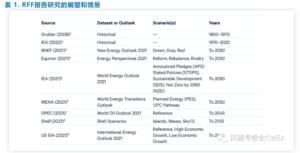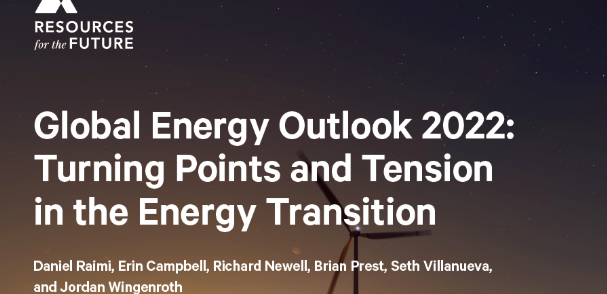Global Energy Outlook 2022: Turning Points and Tension in the Energy Transition
The global energy system faces deep uncertainty in the near, medium, and long terms. Amidst war in Europe, the urgent need to reduce greenhouse gas emissions, and many other factors, long-term energy outlooks offer one lens through which to assess the wide range of potential futures for global energy, emissions, and even geopolitics.
Because these projections vary widely and depend on varying underlying assumptions and methodologies, they are difficult to compare on an apples-to-apples basis. In this report, we apply a detailed harmonization process to compare 19 scenarios across seven energy outlooks published in 2021. Taken together, these scenarios offer a broad scope of potential changes to the energy system as envisioned by some of its most knowledgeable organizations. Table 1 shows the historical datasets, outlooks, and scenarios examined here.

A brief description of our methodology is provided under Data and Methods (Section 4), with select data indicators under Statistics (Section 5). For the full methodology, see Raimi and Newell,10 and for the dataset and interactive graphing tools, visit www.rff.org/geo.
Throughout the figures included in this report, we use a consistent labeling system that distinguishes among the different scenarios (see Table 2):
- For “Reference” scenarios, which assume limited or no new policies, and for scenarios that assume continued geopolitical challenges, we use a long-dashed line: this set comprises IRENA PES, Equinor Rivalry, Shell Islands, OPEC Reference, and US EIA Reference case.
- For “Evolving Policies” scenarios, which assume that policies and technologies develop according to recent trends and/or the expert views of the team producing the outlook, we use solid lines: this set comprises Equinor Reform, IEA STEPS, and Shell Waves.i For IEA APS, which assumes governments implement all announced energy and climate policies, we use a dot-dash format.
- For “Ambitious Climate” scenarios, which are built around limiting global mean temperature rise below 2°C by 2100, we use short-dashed lines: this set comprises BNEF Green, Gray, and Red scenarios; Equinor Rebalance; and IEA SDS.
- Finally, we include an additional set of Ambitious Climate scenarios designed to limit global mean temperature rise to 1.5°C by 2100, which we illustrate with a dotted line: IEA NZE, IRENA 1.5C, and Shell Sky1.5
Key Findings
Global energy markets are under stress. Even before Russia’s invasion of Ukraine, Brent crude spot prices rose from an average of $42/bbl in 2020 to $71/bbl in 2021. By early March 2022, as Russian tanks rolled across the border, Brent prices spiked to more than $120/bbl. Energy outlooks released in 2021 could not have anticipated these events, and only one scenario (the US EIA’s High Oil Price) assumed oil prices reaching today’s levels at any point before 2050.
European natural gas markets have experienced even greater price spikes. Dutch natural gas prices, which had already reached record levels in 2021, surged to more than €165 per megawatt-hour (roughly $54 per MMBtu) in early March, more than 10 times higher than the 2020 average. These price increases burden energy consumers around the world. In the near term, options for easing high prices are limited, but in the medium to longer terms, energy security can be enhanced through reducing oil and natural gas consumption and further diversification of suppliers.
Many options to enhance energy security also align with long-term climate goals. For example, energy efficiency and accelerating the electrification of transportation, heating, and other uses can reduce exposure to volatile hydrocarbon prices. Still, clean energy technologies such as electric vehicles, wind turbines, and solar modules also rely on global supply chains which in some cases are geographically concentrated and inelastic, indicating that geopolitics will continue to play a role in energy markets for the foreseeable future.
Under all Reference and Evolving Policies scenarios, global primary energy consumption grows considerably over the next three decades, but CO2 emissions rise under only half of these scenarios, implying a less carbon-intensive energy mix. Under most Ambitious Climate scenarios, dramatic improvements in energy efficiency lead aggregate primary energy consumption to decline as emissions plummet due to a much cleaner fuel mix.
Source: RFF



